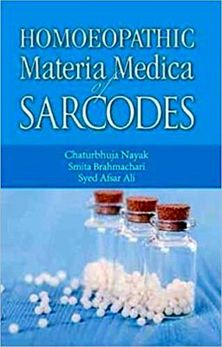Homeopathic Materia Medica of Sarcodes
Chaturbhuja Nayak, Smita Brahmachari, Syed Afsar Ali
B.Jain Publishers. Softcover. 405 pages. ISBN: 978-81-319-3600-9.

I have been using sarcodes in my practice almost since I started seeing patients, with one indication: the repair of tissues and organs that have been injured or are not working properly; organotherapy. Moreover, I always had that notion that sarcodes had not been proved.
This is why I was very enthusiastic to see this book appear on my radar; it is only when I received it that I realised it was a 2020 reprint of a book published in 2016; and looking at the 39 sarcodes listed, I had to quickly change my concept about this category of remedies.
To start by the end, for those who are in a hurry, let me say that this is a remarkable work, now standing handy on a shelf next to my desk; it was extremely instructive and a pleasure to read it. I highly recommend it to every practitioner.
This long sentence means that what you are going to read now is by no way to be understood as being a negative criticism, as I have nothing bad to write about it. It is my collection of reactions and thoughts, which I also offer to the authors in the hope that they will publish an update on their work.
Many things have been written on sarcodes and many discussions have been had. It would widely benefit all of us to enlarge the scope of sarcodes and add the only thing really missing: a repertory.
The introduction is not to be missed, and especially the discussion about what a sarcode is. The general agreement being that it is “a medicine prepared from the healthy tissues, secretions of the endocrine glands and normal secretions of the living human beings and lower animals”; it seems though that some “flexibility” has been introduced, which contradicts that definition, as is discussed on pages 4 and 5.
The sarcode Cortisone in the synthetic form of cortisone; folliculinum is a synthetic form of oestrogen: that makes them tautopathic or isotherapic remedies, not real sarcodes. Milk curd (lac vaccinum coagulatum), defatted cow milk (lac defloratum), cream of milk (lac vaccinum flos) and lactose (saccharum lactis) are artificial modifications of secretions.
This does not remove anything from the value and interest of their Materia Medica, and they have to fit somewhere, especially the milks, but still, the fastidious, concerned about trifles “me”, had to say something about it.
While writing about the Milks, there is some involuntary humour to be found: all of the Milks, with the exception of Lac Humanum, are described as coming from “the female lactating animal” … thanks for the chuckle. I was disappointed not to see Lac Maternum included and especially an interesting differential discussion with Lac Humanum.
Each remedy is presented in a similar format: a definition (introduction), its source, its preparation, the provings when available, the sphere of action (at least the major ones), some clinical conditions where it could be indicated, the characteristic features (the major points of impact of the remedy), the symptomatology, going through the different sections according to the Hahnemannian listing, the dose and potency according to the authors (many of us have different opinions about that), cautions when necessary for remedies that can cause problems, the extremely important and useful section of comparison with remedies having similar symptoms and signs, allowing us to make a reasoned choice and not an automatic application, some success stories of famous clinicians, which unfortunately do not explain why that sarcode was chosen and not another one, finishing with a list of references.
As I already wrote, the only missing part in this book is a repertory. It is my experience that when using the available repertories, be it manually or in a software, sarcodes, like nosodes rarely appear as much indicated, which is totally contradicted by what you will read in this book.
To conclude as I started, there should be no hesitation in acquiring and reading it. It is an extra tool, and an important one at that, in our armamentarium. Don’t be without it!
Dr. Joe Rozencwajg, NMD
New Plymouth, New Zealand.






In Bangladesh how can I get this wonderful Sercode Materia Medica?
Try ssbjain publishers. http://www.bjainbooks.com